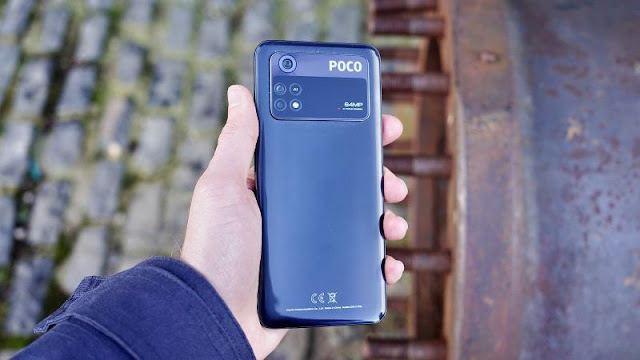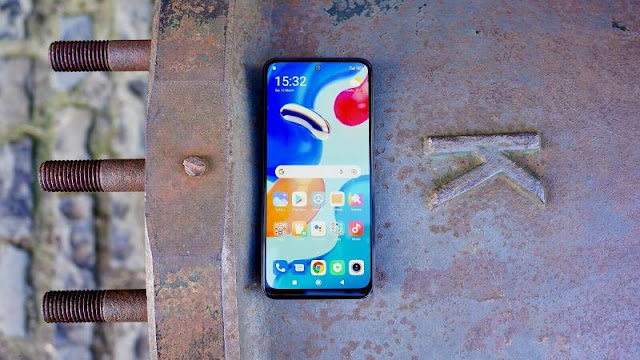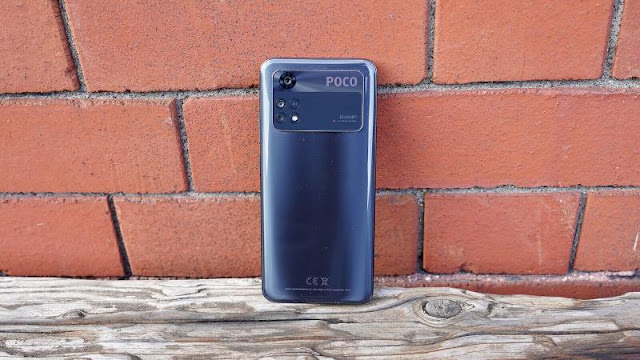The Poco M4 Pro might sacrifice 5G connectivity, but the result is Poco’s best budget phone of 2022 so far.
Should I Buy The Xiaomi Poco M4 Pro?
Pros
- First AMOLED display in the M-range
- Improved 64MP camera
- Easy-to-manage design
- Solid battery life
Cons
- No 5G
- MIUI still not fantastic
- Doesn’t prove exceptional in a competitive field
- Pointless macro lens
Our Verdict
Price When Reviewed
- Unavailable in the US
Poco phones traditionally give you a high degree of all-round multimedia competence for a budget price, and the Xiaomi Poco M4 Pro is no different.
Despite what the name might suggest, the Poco M4 Pro is much more than just a Poco M4 Pro 5G with the next-gen network connectivity lopped off.
It’s a surprisingly different package, from its design to its display, and from its camera to its CPU. Let’s not mince words here: the Poco M4 Pro is flat out the superior phone to its 5G brother and should be the preferred pick for anyone willing to forego the very fastest network speeds.
Design & Build
- 8.1mm
- 179.5g
- No IP rating
Like the Poco M4 Pro 5G, the Poco M4 Pro does a pretty good impression of a flagship phone. Catch a quick glance of the phone lying face down on a table, and you might just be convinced into thinking that it’s worth three times its asking price.
Interestingly, Poco has mixed that rear design up a little from the 5G model. And I'm not just talking about the glossier, more reflective finish. While the latter goes with a vertical camera module sat within a flat black block, the 4G model gives you a whole extended camera module that spans most of the width of the phone.
Not all of that is actually camera, and the module still seems to be housed within a similar vertical strip in the top left corner. But it does leave the phone feeling more balanced – quite literally when it comes to laying it down on a flat surface.
There are only three colours on offer with the Poco M4 Pro, but there’s quite a dramatic difference between the sober Power Black model I tested and the vibrant Poco Yellow model that you see in the press materials. There’s also a Cool Blue version that falls somewhere in between these two poles.
One of Poco’s signature features is a set of dual speakers, and they’re present and correct on the M4 Pro. This shouldn’t be taken for granted, with even the £300 OnePlus Nord CE 2 opting for a mono speaker.
Screen
- A switch to AMOLED
- 6.4in 90Hz
- Impressive colour and brightness
The display used on the Poco M4 Pro is completely different to the 5G model. It’s slightly smaller at 6.4in (versus 6.6in), but it’s by no means small, and it packs the same 2400 x 1800 Full HD+ resolution.
Both screens have 90Hz refresh rates, though they default to 60Hz. You also get a 180Hz tough sampling rate with the M4 Pro, which means it's nice and responsive for fast-paced action games.
But the main talking point here is the switch to AMOLED panel technology – the first of its kind to appear in Poco’s M-series, no less. This makes the Poco M4 Pro screen infinitely more vibrant than the Poco M4 Pro 5G’s LCD, with greater dynamic range, deeper blacks, and purer whites.
I recorded a peak brightness of 428 nits with auto-brightness switched off, but Xiaomi claims that it can hit a full 1000 nits with auto-brightness switched on. That’s effectively flagship-level with even the Xiaomi 12 quoted at 1100 nits.
All in all, this display seems to be the exact same component that Xiaomi uses in the Xiaomi Redmi Note 11 and Redmi Note 11S. I was impressed with it in those phones, and I’m equally impressed with it here in the similarly priced Poco M4 Pro.
Specs & Performance
- MediaTek Helio G96
- 6/8GB RAM
- 128/256GB storage
While the Poco M4 Pro 5G runs on the MediaTek Dimensity 810, the Poco M4 Pro runs on the MediaTek Helio G96. This latter chip is built using an older and less efficient 12nm process (vs 6nm), and it’s the same processor that runs the Redmi Note 11S and the Realme 8i.
Conversely, the Poco M4 5G chip seems to have a slightly better GPU, with all of our GFX Bench benchmark tests revealing an advantage of a few frames per second over the Poco M4 Pro.
In real-world terms, there isn’t a great deal between them. The M4 Pro feels nice and slick, if not super-silky like a true flagship.
The model I’m testing runs 6GB of RAM, but there is an 8GB model out there. Regardless, the Poco M4 Pro can make use of Xiaomi’s Dynamic RAM Expansion Technology, which can borrow 3GB of internal storage from the 128- or 256GB of ROM for extra memory.
Talking of storage, there’s a microSDXC slot for expansion purposes.
Cameras
- 64Mp main camera
- 8Mp ultrawide
- 2Mp macro
- 16Mp selfie camera
The Poco M4 Pro features a triple-camera system led by a 64Mp sensor, which is the first of its type to make an appearance in the M-series. The 5G model, for the record, utilises a 50Mp sensor.
By default, the camera takes 16Mp shots using 4-in–1 pixel binning, but you can opt to go all-in with 64Mp shots if you so wish.
This main sensor is backed by an 8Mp ultra-wide and a 2Mp macro sensor. And yes, the latter is as pointless here as it is almost everywhere else.
There’s no telephoto here, so the phone crops in using the main sensor. Having a higher megapixel count helps, with less of a drastic drop in detail – provided you don’t examine those shots too closely. This might be where you want the full 64Mp.
The 8Mp ultra-wide predictably lacks detail, but the tone isn’t completely removed from the superior main sensor, which is a big advantage. It is more prone to overexposure, though, which is kind of inevitable at this end of the market.
Night mode doesn’t compete with more expensive phones but does a creditable job of brightening up scenes.
Video recording is disappointingly weedy at 1080p at 30fps. The Poco M4 Pro 5G can at least hit 1080p at 60fps.
Battery Life & Charging
- 5000mAh
- 33W fast charging
- Adapter included
The Poco M4 Pro is powered by a 5000mAh battery. That’s nice and large, but also pretty typical of phones in this pricing category.
As with other budget contenders, it’s good for a full day of heavy usage and potentially a full two days of light to moderate usage.
What’s interesting is that the Poco M4 Pro performed slightly better than the M4 Pro 5G in our standard battery test. Running the PCMark Work 3.0 battery benchmark, which simulates a phone’s battery performance under a sustained but mixed load, the Poco M4 Pro lasted 10 hours and 56 minutes, compared to 10:39 for the 5G.
Charging speeds are very similar to the Poco M4 Pro 5G, as you’d expect given the identical battery size and the exact same 33W charger supplied in the box. I was able to get from 0 to 29% in 15-minutes, and up to 59% in half an hour. A full hour on charge got me right up to 99%.
Software & Apps
- Android 11
- MIUI 13
The Poco M4 Pro runs on MIUI 13 layered on top of Android 11. It’s still not the most appealing Android skin, with its gauche icons and the full-page notification that pops up every time you install an app.
It’s simple enough to use, though, with Google Feed to the left and an iOS-like split between the control center and notification pane. This can be deactivated according to your preference, of course.
Indeed, MIUI’s personalisation potential is its key strength. The Themes app provides a veritable store front of custom home screens and matching icon packs, potentially lending your phone an entirely fresh look.
Even so, MIUI is getting to be quite comfortable to use these days, even if that’s merely because it’s so ubiquitous.
Price & Availability
The Poco M4 Pro is available now at a starting price of £189 for 6GB of RAM and 128GB of storage. The 8GB/256GB model is being offered for £249.
- 6/128GB - £189/€219
- 8/256GB - £249/€269
This puts the Poco M4 Pro in roughly the same pricing category as the Poco M4 Pro 5G. Remember, though, that you get more storage and RAM for your money.
Verdict
The Poco M4 Pro takes things in a surprisingly different direction to the Poco M4 Pro 5G. Though you may lose 5G connectivity, you gain quite a bit more in return.
It enables the inclusion of the first AMOLED display in the series, as well as the first 64Mp main camera.
It’s debatable whether the Poco M4 Pro’s unique design is any better than its brother’s, but the fact that some effort has gone into making it different is worthy of praise. It’s undeniably a little more compact and thus easier to use single-handed, too.
Throw in more generous RAM and storage options, and you have a well-equipped budget phone that just feels that tiny bit more premium than its close brother.
Specs
- Android 11
- 6.43in, FHD+, AMOLED, 90Hz, flat display
- Side-mounted fingerprint sensor
- Mediatek Helio G96
- 6GB/8GB LPDDR4 RAM
- 128GB/256GB storage
- 64Mp, f/1.8 main camera
- 8Mp ultra-wide camera
- 2Mp macro camera
- Up to 1080p @ 30fps rear video
- 16Mp front-facing camera
- Stereo speakers
- Dual-SIM
- Wi-Fi 802.11 a/b/g/n/ac
- Bluetooth 5.0
- 5000mAh battery
- 33W charging
- 159.87 x 73.87 x 8.09 m
- 179.5g
- Launch colours: Graphite Gray, Pearl White, Twilight Blue






.jpg)
.jpg)
.jpg)
.jpg)
.jpg)
.jpg)
.jpg)
.jpg)
.jpg)
.jpg)
.jpg)
.jpg)
.jpg)




0 comments:
Post a Comment